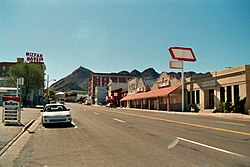Tonopah, Nevada
Tonopah, Nevada | |
|---|---|
 Main Street & Mizpah Hotel, Tonopah | |
| Nickname: Queen of the Silver Camps[1] | |
 Location of Tonopah, Nevada | |
| Country | United States |
| State | Nevada |
| Government | |
| • Senate | Mike McGinness (R) |
| • Assembly | Ed Goedhart (R) |
| • U.S. Congress | Dean Heller (R) |
| Area | |
• Total | 16.2 sq mi (42.0 km2) |
| • Land | 16.2 sq mi (42.0 km2) |
| • Water | 0.0 sq mi (0.0 km2) |
| Elevation | 6,047 ft (1,843 m) |
| Population (2000) | |
• Total | 2,627 |
| • Density | 162.1/sq mi (62.6/km2) |
| Time zone | UTC-8 (Pacific (PST)) |
| • Summer (DST) | UTC-7 (PDT) |
| ZIP code | 89049 |
| Area code | 775 |
| FIPS code | 32-73600 |
| GNIS feature ID | 0845985 |

Tonopah is an unincorporated town and census-designated place (CDP) in Nye County, Nevada, United States. The population was 2,627 at the 2000 census. It is the county seat of Nye CountyTemplate:GR.
Tonopah Test Range is located nearby.
Geography
Tonopah is located at the junction of U.S. Highway 6 and 95 en route from Las Vegas to Reno.
According to the United States Census Bureau, the CDP has a total area of 16.2 square miles (42.0 km²), all of it land.
History
In 1903, miners rioted against Chinese workers in Tonopah, which spurred a boycott in China of US goods. The town started about 1900 with the discovery of rich gold/silver ore by the lost burro of a prospector, Jim Butler. The burro had wandered off during the night and had sought shelter near a rock outcropping. When Butler discovered the animal the next morning, he picked up a rock to throw at the beast, but instead noticed the rock was unusually heavy. He had stumbled upon the second-richest silver strike in Nevada history. The ore eventually played out, and abandoned mines can be found throughout the area.
Recently, Tonopah has relied on the nearby Tonopah Test Range as its main source of employment. The military has used the range and surrounding areas as a nuclear test site, a bombing range, and as a base of operations for the development of the F-117 Nighthawk.
Demographics
As of the censusTemplate:GR of 2000, there were 2,627 people, 1,109 households, and 672 families residing in the CDP. The population density was 162.1 people per square mile (2.59/km²). There were 1,561 housing units at an average density of 96.3/sq mi (37.2/km²). The racial makeup of the CDP was 91.24% White, 0.76% African American, 1.41% Native American, 0.42% Asian, 0.30% Pacific Islander, 2.82% from other races, and 3.05% from two or more races. Hispanic or Latino of any race were 6.17% of the population.
There were 1,109 households out of which 32.2% had children under the age of 18 living with them, 48.9% were married couples living together, 7.5% had a female householder with no husband present, and 39.4% were non-families. 34.2% of all households were made up of individuals and 10.1% had someone living alone who was 65 years of age or older. The average household size was 2.33 and the average family size was 3.03.
In the CDP the population was spread out with 27.1% under the age of 18, 6.2% from 18 to 24, 29.3% from 25 to 44, 27.3% from 45 to 64, and 10.1% who were 65 years of age or older. The median age was 39 years. For every 100 females there were 108.3 males. For every 100 females age 18 and over, there were 105.9 males.
The median income for a household in the CDP was $37,401, and the median income for a family was $47,917. Males had a median income of $40,018 versus $22,056 for females. The per capita income for the CDP was $18,256. About 5.7% of families and 11.2% of the population were below the poverty line, including 7.3% of those under age 18 and 19.1% of those age 65 or over.
Culture
This article contains a list of miscellaneous information. (September 2008) |
- Tonopah's current fame rests largely on the reference to it in the chorus of the song "Willin'" by Lowell George of Little Feat on the albums Little Feat,Sailin' Shoes and Waiting for Columbus:
And I've been from Tucson to Tucumcari, Tehachapi to Tonopah.
I've driven every kind of rig that's ever been made;
driven the backroads so I wouldn't get weighed.
It is also possible that the song is actually referring to Tonopah, Arizona, in which case that fame is misplaced.
References
Further reading
"A History of Tonopah Nevada", by Robert D. McCracken (1992), ISBN 1-878138-52-9

